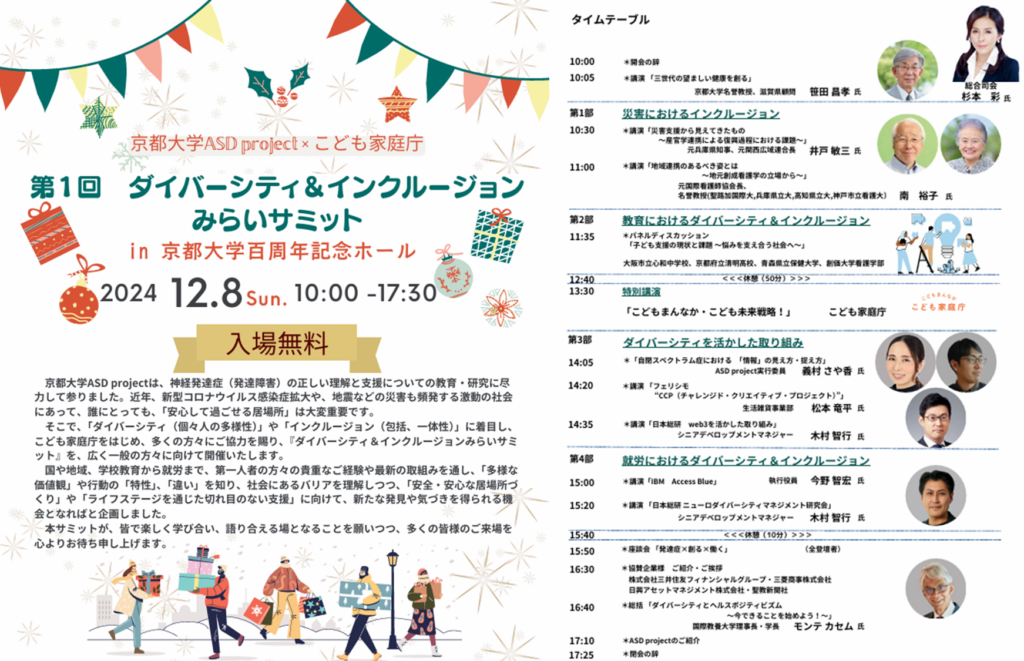The 1st Diversity & Inclusion Future Summit was held on December 8, 2024. The contents of the summit are as shown in the image below, and we were able to hear lectures by people from diverse backgrounds. The program also included lectures by Professor Yoshimura of the Graduate School of Medicine at our university and Researcher Kimura of the Japan Research Institute, who are the representatives of the SMBC Kyoto University Studio (hereinafter referred to as the Studio) joint venture(*), and the Studio also participated as a supporting organization to provide support. In this article, we will provide an overview of the lectures by Professor Yoshimura and Researcher Kimura of the Japan Research Institute at the Summit, as well as the Studio's impressions.
(*) "Support for people with developmental disabilities to demonstrate their abilities in the workplace"

How people with autism spectrum disorder see and understand information (Kyoto University/Professor Yoshimura)
In this lecture, the focus of the studio's theme was on how people with autism spectrum disorder (ASD) see and perceive "information."
In general, people with ASD tend to have a low ability to naturally respond and interact with others, and are prone to things like "attachment to constancy" and "repetition." Research has shown that these tendencies are closely linked to a strong interest in "objects" and "details." For example, when watching a scene from a movie, typically developing people will focus on the eyes of the characters. On the other hand, it has been confirmed that people with autism, a type of ASD, focus on "objects" around the characters. In addition, the researchers explained characteristics shown in experiments, such as difficulty processing moving objects, such as changes in human facial expressions, and a tendency to remember memories in images and in fragments of episodes.
I felt that this way of seeing and understanding "information" is expressed in words and actions, and may also be the source of outstanding abilities in advanced, cutting-edge IT fields and the arts.
Japan Research Institute Web3 Initiative (Japan Research Institute/Researcher Kimura)
This lecture introduced the efforts of the NFT project "Good Job! Digital Factory," which aims to create new jobs and culture in society with people with disabilities through the power of art and digital technology. It is being undertaken in collaboration with the social welfare corporation Wataboushi no Kai and the Japan Research Institute.
What particularly made an impression on me was the NFT art "Good Job-san," which was on sale. "Good Job-san" is a character that combines a design created by an artist with a disability with body parts created by people with and without disabilities. There are 100 different body parts, and by combining the designs and parts, there are an astonishing 1,000 different "Good Job-sans." What's more, as this NFT art utilizes blockchain technology, each piece is unique. When you purchase it, you don't just get a piece of art, you're also given voting rights that will affect the direction of future product development.
While I was fascinated by the vivid designs and innocent faces of "Good Job-san," I learned a lot from his work, which involves people in art and the community, and which has much in common with my studio.
In addition, Researcher Kimura of the Japan Research Institute introduced the efforts of the Neurodiversity Management Study Group. Using corporate practice as a model, this study group is researching management methods for people with developmental disabilities, aiming to create an environment in which they can thrive. As this initiative is deeply related to the theme of the studio, we hope to cover this separately and introduce it to you.
Finally, we received comments from Professor Yoshimura and Researcher Kimura.
Professor Yoshimura, Kyoto University
We were able to hear from people who have been working on diversity and inclusion in various ways in fields such as government, child-rearing, education, employment, and medicine. From the details of their specific efforts, we were able to understand what we should be conscious of in our daily activities in order to create "a place where everyone can feel safe and secure." The content was highly praised by the participants, and as the organizer, I am pleased about that.
Japan Research Institute Researcher Kimura
At this summit, we were able to hear speeches from people who are working on diversity and inclusion with a very high perspective. It was an opportunity to reaffirm the essence of diversity and inclusion, and we also received a lot of encouragement for the activities of JRI, including the studio. We look forward to the future development of the ASD Project.


